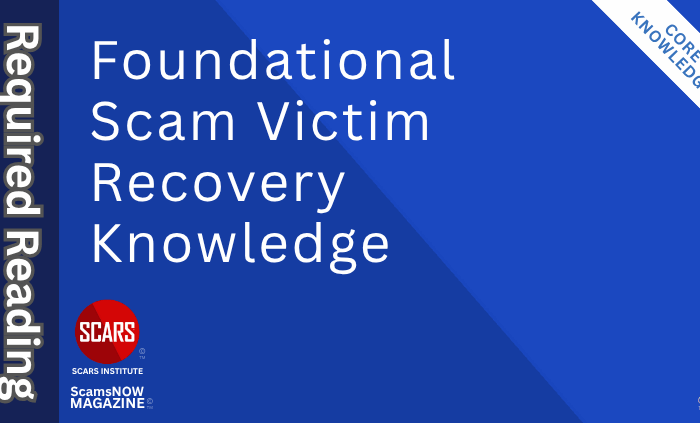Changing the Past and the Future – Scam Victims And the Bootstrap Paradox
The Bootstrap Paradox of Scam Victims’ Recovery: When Pain Sustains Itself and Breaking the Cycle and Escaping the Self-Created Loops After Scam Trauma
Primary Category: Scam Victim Recovery Philosophy
Intended Audience: Scam Victims-Survivors / Family & Friends
Author:
• Tim McGuinness, Ph.D., DFin, MCPO, MAnth – Anthropologist, Scientist, Polymath, Director of the Society of Citizens Against Relationship Scams Inc.
About This Article
The Bootstrap Paradox explains how scam victims can unknowingly sustain their own emotional suffering long after the scam ends, caught in self-reinforcing cycles of shame, guilt, distrust, and isolation. Just as in a time-travel paradox where an object or idea has no clear origin, scam victims may find their pain continually recreated not by the scammer, but by their own unresolved emotional reactions.
Recognizing these internal loops is critical. By confronting distorted beliefs, reconnecting with supportive people, engaging in small acts of trust-building, and allowing new emotional inputs, victims can break free from the Bootstrap Loop and rebuild their lives. Recovery is not about erasing the past; it is about refusing to let past pain define the present or the future.

The Bootstrap Paradox of Scam Victims’ Recovery: When Pain Sustains Itself and Breaking the Cycle and Escaping the Self-Created Loops After Scam Trauma
From Betrayal to Endless Suffering: The Psychological Bootstrap Paradox in Scam Victims
Ok, you will probably need to be sitting to explore this article about Time Travel and the Bootstrap Paradox. It may get a little weird.
Let’s start with some basics: What is Time?
Dr. Tim’s Primer on What Time Is
In the most basic sense, time is one part of the coordinate system that describes our universe. It is not separate from space. Instead, time and space together form what is called space-time.
In familiar terms, you can think of the universe as a four-dimensional grid.
- 1 2 3: Three of these dimensions are spatial: length, width, and height.
- 4: The fourth dimension is time.
When you describe an event happening somewhere, you need to specify where and when.
“Where” requires three coordinates (such as latitude, longitude, and altitude).
“When” requires one coordinate (a moment in time, like a clock reading).
Together, these four coordinates uniquely define a point in space-time.
Traditional View (3 Space + 1 Time)
- 1 2 3: Three coordinates describe the position in space (x, y, z).
- 4: One coordinate describes the position in time (t).
This is how we usually experience reality: we move through space and perceive time passing as a separate, flowing dimension.
Think of it like this
You want to know where you will be for an appointment next Tuesday. You have the spatial coordinates for the location, and then the time you need to be there. That is how space-time works in our daily lives. This is the model that our brains can more easily understand.
Except, of course, time does not stand still. There is no actual present, time is always flowing.
Alternative View (3 Time + 1 Space)
In theoretical physics, it is also possible—at least mathematically—to imagine a different structure:
- 1 2 3: Three dimensions describe different aspects of time.
- 4: One dimension describes position in space.
This idea is not how we normally view how our everyday universe works, but it is a valid mathematical model in certain advanced theories. In such a structure, “time” could have directions similar to how we think about spatial directions, and “space” could be confined to a single axis.
Of course, I am not going to get into more advanced stuff about how our universe actually functions, just how we perceive it.
So think of this view like this: If it were possible to move through time, then we could be stationary at a single spacial coordinate, and the coordinates of time would then be changing.
Why Time Matters in Space-Time
Without time, space would be static. Nothing would move, change, or evolve. Time gives meaning to motion and causality. It allows for cause and effect, growth, decay, and all the processes that structure the universe.
In Einstein’s theory of relativity, space and time are so interconnected that changing your motion through space alters your experience of time. They are not separate entities but part of one fabric that bends and stretches under the influence of mass and energy.
Remember
-
Time is not just a “clock ticking.”
-
It is a fundamental coordinate, just like left-right, up-down, and forward-backward.
-
Our universe is described by three dimensions of space and one dimension of time.
-
Alternative theories can flip this balance, although they do not match ordinary experience.
Understanding time as a coordinate, rather than just as a flow, is essential to understanding how the universe is built at its deepest levels that we perceive.
Let’s Talk about Time Travel and the Bootstrap Paradox
The Bootstrap Paradox is a time-travel concept where an object, piece of information, or person exists without a clear point of origin because it is passed back in time and becomes trapped in an endless cause-and-effect loop. In short, it describes a situation where something creates itself.
Here is a simple way to understand it:
-
A person travels back in time with a book.
-
They leave the book in the past.
-
Someone finds the book and republishes it.
-
That book is then handed down through history, eventually reaching the original time traveler, who then takes it back in time again.
At no point was the book originally written. It exists because of the time loop, not because someone actually created it from scratch. The paradox is that the book’s origin cannot be determined—it simply exists.
Don’t worry, a couple of Tylenol will help that headache!
Key elements of the Bootstrap Paradox:
-
There is no clear creation event.
-
Cause and effect are circular rather than linear.
-
The loop seems self-sustaining, but logically, it should not be possible.
The name “bootstrap” comes from the old phrase “pulling yourself up by your bootstraps,” meaning achieving something impossible, like lifting yourself into the air by pulling on your own boots. Scam victims should understand that phrase very well, since they have to pull themselves up and recover by their bootstraps – so to say!
Real-World Thought Experiments About the Bootstrap Paradox
Before we move on to how this makes any sense to scam victims, indulge me a bit longer. I promise this will all make sense, or not.
The Composer Paradox
-
- Imagine a time traveler who adores Beethoven’s music. He travels back in time to meet Beethoven but finds that Beethoven never actually composed any music.
- Not wanting the world to lose Beethoven’s work, the traveler gives him copies of all his symphonies.
- Beethoven then publishes the music.
- Question: Who originally composed the music?
- Answer: No one. The music exists in a causality loop without a true origin.
The Scientist’s Invention
-
- A scientist receives plans for a revolutionary machine from an older version of themselves traveling from the future.
- They build the machine, become famous, and in their old age travel back in time to deliver the plans to their younger self.
- Question: Where did the invention actually come from?
- Answer: It has no true point of creation. It exists because of the loop.
Famous Pop Culture Examples
1. Donnie Darko – The Philosophy of Time Travel
-
-
- As we discuss below, the fictional book The Philosophy of Time Travel guides Donnie’s actions to save the universe, but its knowledge was influenced by the events Donnie himself triggered.
- The book’s knowledge has no independent origin—it is caught in a causal loop.
-
2. Doctor Who – “Blink” (Sally Sparrow and the Timey-Wimey Letter)
-
-
- In the episode “Blink,” Sally Sparrow receives a letter from the Doctor, who is trapped in the past.
- She uses the information in the letter to help him escape.
- However, the only reason the Doctor knows to write the letter is because Sally told him what to do—based on the information in the letter.
- The letter has no clear starting point.
-
3. Harry Potter and the Prisoner of Azkaban – The Time-Turner
-
-
- Harry and Hermione use a Time-Turner to go back and save Sirius Black.
- At one point, Harry sees a Patronus saving himself, thinking it is his father.
- Later, after time traveling, he realizes it was himself who cast it.
- The act is a closed loop—the cause (the Patronus) and the effect (him learning to cast it) sustain each other without an outside origin.
-
4. Predestination (2014 Film)
-
-
- In Predestination, a time-traveling agent is tasked with stopping a criminal known as the Fizzle Bomber.
- As the story unfolds, it is revealed that the agent and the bomber are different versions of the same person, caught in a self-creating identity loop.
- The person exists purely because of time travel—no “original” version ever existed outside the loop.
-
5. The Terminator Series – Skynet’s Creation
-
-
- In the Terminator films, Skynet (the AI that destroys humanity) is developed using technology found from the destroyed Terminator sent from the future.
- Thus, Skynet’s creation is based on its own future existence—without it, the technology would not have been there.
-
Are you thoroughly confused? In all these examples, an object, piece of information, or person exists in a circular causal relationship. There is no true point of origin—the thing exists because of itself, forming a paradox.
The Bootstrap Paradox is fascinating because it challenges our understanding of cause and effect, making us question whether everything must have a clear beginning.
The Philosophy of Time Travel and the Bootstrap Paradox
In the movie “Donnie Darko” there is a book called “The Philosophy of Time Travel.” which is a good example of a Bootstrap Paradox. If you have never seen the movie, we recommend it, but for now skip this section.
Here is how it fits:
-
Roberta Sparrow (Grandma Death) wrote The Philosophy of Time Travel after some experience with time anomalies.
-
The book explains how tangent universes work and guides Donnie in understanding his role.
-
Donnie’s actions at the end of the movie, including his choices about the jet engine and saving the universe, are heavily influenced by reading that book.
-
Yet the events that inspire or enable Roberta Sparrow to write the book were influenced by Donnie’s actions after reading it.
This creates a circular, self-sustaining loop:
-
Roberta writes the book based on knowledge from events caused by someone who read the book she wrote.
-
The book has no clear original source of knowledge outside the time loop.
In other words, the information in the book exists because of the time loop itself. There is no independent “first” moment where Roberta learned the principles she described. It is a closed causal circle, which is the essence of a Bootstrap Paradox.
Donnie Darko uses the paradox to create a sense of fatalism — events are both inevitable and self-created — and it blurs the line between destiny and free will.
Would you also like me to show a simple diagram of how the loop works in Donnie Darko? It can make it even easier to visualize.
Got it?
Bootstrap-Like Loops in Scam Victim Recovery
Now that you learn all of that, let’s apply the hypothesis of the Bootstrap Paradox to Scam Victim in recovery.
After a scam, victims often find themselves caught in self-reinforcing psychological cycles. These cycles are combinations of multiple mental and brain processes. However, in an odd way, these cycles mirror the Bootstrap Paradox because the victim’s pain, guilt, fear, and distrust create mental and emotional patterns that sustain themselves without a clear external cause anymore.
- At the beginning, the scammer causes the damage.
- But later, the victim’s own thoughts, emotions, and beliefs sustain the damage, even after the scammer is long gone.
- The original injury fades into the background, and the emotional loop continues feeding itself.
A Practical Example:
-
A victim is scammed and feels deep shame.
-
Because of the shame, they isolate themselves from others.
-
Isolation prevents them from getting support, which keeps the shame alive.
-
The shame reinforces their belief that they cannot trust themselves.
-
Because they cannot trust themselves, they believe they will always be vulnerable.
-
Feeling vulnerable keeps the original emotional wound open.
-
The cycle repeats indefinitely.
In this loop, the original event (the scam) is no longer the main driver. The victim’s reaction to the event sustains the emotional harm. It becomes a “bootstrap” cycle — pain feeding pain, shame feeding shame — without any new external input.
Psychological “Bootstrap Paradox” Risks for Scam Victims:
-
Self-perpetuating guilt: Believing “I should have known better” continues to produce shame without new evidence.
-
Persistent distrust: Refusing to trust others because of the betrayal, which prevents healing experiences and confirms their worst fears.
-
Identity damage: Seeing oneself permanently as a “victim,” which ensures that recovery feels impossible, even when it is very possible.
-
Emotional self-sabotage: Turning away help, sabotaging relationships, or refusing new opportunities to protect themselves from further disappointment — but actually trapping themselves in longer-term suffering.
In all these cases, the original scam caused the first injury, but the ongoing suffering is maintained by an emotional and cognitive loop that creates itself, just like in a Bootstrap Paradox.
Signs You May Be Caught in a Bootstrap Loop After a Scam
Recognizing the signs that you are stuck in a self-sustaining emotional loop after a scam is an important step toward breaking free and moving forward. Here are key indicators to watch for:
- Replaying the Event Without Resolution: You constantly replay the scam in your mind, searching for what you “should have” done differently, but never feel any closer to closure or understanding.
- Persistent Self-Blame: You continue to believe that the scam was entirely your fault, even when you logically know scammers use professional-level manipulation techniques against victims.
- Isolation From Support Systems: You distance yourself from friends, family, or support groups, believing they cannot understand you or that you do not deserve their help.
- Difficulty Trusting Anyone: You avoid building new relationships or accepting assistance because you fear being betrayed again, even when there are no signs of real danger.
- Emotional Reactions Without Clear Triggers: You experience anger, sadness, or fear suddenly and intensely, without any clear external cause, often directed at yourself or others unfairly.
- Refusing New Opportunities: You turn down positive opportunities for recovery, learning, or growth because you feel convinced that failure or betrayal is inevitable.
- Belief That Healing Is Impossible: You tell yourself that you will “never recover” or “never be the same,” creating a self-fulfilling prophecy that blocks progress.
- Reinforcing Negative Identity Labels: You describe yourself primarily in terms of the victimization (“I am stupid,” “I am broken”) rather than as a person who experienced trauma but is capable of recovery.
If you recognize several of these signs in yourself, it may mean that you are caught in a psychological Bootstrap Loop.
Awareness is the first step. With targeted support, compassionate self-understanding, and active steps toward recovery, you can break the cycle and build a new path forward based on resilience, not regret.
How to Break the Psychological Loop
-
Awareness: Recognize that what keeps you trapped now may no longer be the scammer’s actions but your own emotional responses.
-
Self-Compassion: Replace self-blame with an understanding that emotional loops are natural trauma responses, not evidence of failure.
-
Seeking Help: Allow support, therapy, education, and community into your life to introduce external inputs that can break the self-contained cycle.
-
Reframing Identity: See yourself not as a permanent victim but as a survivor actively moving forward, which shifts the loop toward growth instead of reinforcement of pain.
-
Small Trust Exercises: Carefully building trust again — not by ignoring risk, but by creating small, safe experiences of human connection — reprograms the brain to loosen the grip of isolation and fear.
In short: A scam can trap you inside an emotional Bootstrap Paradox — a cycle that seems to have no beginning or end because your mind keeps the injury alive even after the scam ends. Breaking the loop is possible, but it requires conscious awareness, support, and the rebuilding of emotional trust over time.
Of Almost Forgot: Changing the Past and the Future!
Changing the Past and the Future by Reframing and Breaking Free from Emotional Loops. While no one can physically travel through time to undo what happened, you have far more power over your past and your future than it may first appear. In fact, the only place your past truly lives is in your memory. And memory is not a static recording—it is active, emotional, and subject to change through conscious effort.
This means that you can change the emotional reality of your past through a process called reframing.
Reframing the Past
Reframing is the psychological practice of looking at past events from a different, healthier, and often more accurate perspective.
It does not mean denying what happened. It means changing the meaning you assign to it.
For scam victims, this can be a transformative tool.
Instead of viewing yourself as “stupid,” “naive,” or “weak,” you can reframe your experience:
-
-
- “I was targeted because I am trusting and compassionate, not because I am foolish.”
- “The scam exploited universal human vulnerabilities, not personal defects.”
- “Being scammed does not define me. Surviving it and choosing to heal does.”
-
When you reframe your experience, you do not erase what happened. Instead, you reclaim control over its meaning.
This changes the emotional power the past holds over you. It weakens the Bootstrap Loop by shifting the emotional weight from shame and guilt toward resilience, strength, and growth.
Changing the Future
Changing the future does not require a time machine. It requires only one thing: breaking the harmful cycles in the present.
Every time you make a decision that supports healing rather than repeating negative patterns, you are changing your future trajectory. Letting go of self-blame, trusting again carefully, reaching out for help, accepting your worth—these actions alter the future path of your life, moving you away from endless emotional loops and toward authentic recovery.
You are not locked into the future that fear, shame, or despair might predict. Each decision you make today—however small—is a pivot point. Choosing healing actions deliberately interrupts the Bootstrap Loop and sets a new course, one defined not by the scammer’s crime, but by your own strength and wisdom.
Why This Matters
If the past exists primarily in your mind, and the future is shaped by what you choose today, then you are not trapped. You have the ability to reshape your relationship to the past and build a future based on self-respect, emotional freedom, and personal growth.
You cannot change that you were targeted. But you can absolutely change what the experience means to you—and what you will build from it going forward.
This is how you defeat the Bootstrap Loop, not by undoing time, but by reclaiming your mind, your choices, and your power.
Conclusion
Understanding the Bootstrap Paradox offers scam victims a powerful new perspective on their recovery journey. In the immediate aftermath of a scam, the harm and betrayal are external, inflicted by the scammer. However, as time passes, victims can find themselves caught in a self-sustaining emotional loop where guilt, shame, distrust, and isolation feed upon themselves, even after the external threat is gone. This psychological “Bootstrap Loop” sustains suffering without a fresh cause, making recovery feel impossible when, in fact, it is still achievable. Recognizing the loop, challenging self-reinforcing beliefs, reconnecting with safe support systems, and rebuilding trust carefully and deliberately are essential steps toward healing. You are not trapped by the original event forever—you are trapped by a pattern that can be broken. With awareness, compassion for yourself, and a willingness to confront these internal cycles, you can step outside the loop and reclaim your emotional freedom. Recovery is not only possible; it is within reach if you recognize that you hold the key to ending the cycle.
Please Rate This Article
Please Leave Us Your Comment Below
Also, tell us of any topics we might have missed.
-/ 30 /-
What do you think about this?
Please share your thoughts in a comment above!
-/ 30 /-
What do you think about this?
Please share your thoughts in a comment above!
ARTICLE RATING
TABLE OF CONTENTS
- The Bootstrap Paradox of Scam Victims’ Recovery: When Pain Sustains Itself and Breaking the Cycle and Escaping the Self-Created Loops After Scam Trauma
- About This Article
- The Bootstrap Paradox of Scam Victims’ Recovery: When Pain Sustains Itself and Breaking the Cycle and Escaping the Self-Created Loops After Scam Trauma
- From Betrayal to Endless Suffering: The Psychological Bootstrap Paradox in Scam Victims
- Let’s start with some basics: What is Time?
- Let’s Talk about Time Travel and the Bootstrap Paradox
- Real-World Thought Experiments About the Bootstrap Paradox
- The Philosophy of Time Travel and the Bootstrap Paradox
- Bootstrap-Like Loops in Scam Victim Recovery
- Signs You May Be Caught in a Bootstrap Loop After a Scam
- How to Break the Psychological Loop
- Of Almost Forgot: Changing the Past and the Future!
- Conclusion
CATEGORIES
U.S. & Canada Suicide Lifeline 988
![NavyLogo@4x-81[1] Changing the Past and the Future - Scam Victims And the Bootstrap Paradox - 2025](https://scamsnow.com/wp-content/uploads/2025/04/NavyLogo@4x-811.png)
ARTICLE META
3 Comments
Leave A Comment
Important Information for New Scam Victims
- Please visit www.ScamVictimsSupport.org – a SCARS Website for New Scam Victims & Sextortion Victims.
- SCARS Institute now offers its free, safe, and private Scam Survivor’s Support Community at www.SCARScommunity.org – this is not on a social media platform, it is our own safe & secure platform created by the SCARS Institute especially for scam victims & survivors.
- SCARS Institute now offers a free recovery learning program at www.SCARSeducation.org.
- Please visit www.ScamPsychology.org – to more fully understand the psychological concepts involved in scams and scam victim recovery.
If you are looking for local trauma counselors, please visit counseling.AgainstScams.org
If you need to speak with someone now, you can dial 988 or find phone numbers for crisis hotlines all around the world here: www.opencounseling.com/suicide-hotlines
Statement About Victim Blaming
Some of our articles discuss various aspects of victims. This is both about better understanding victims (the science of victimology) and their behaviors and psychology. This helps us to educate victims/survivors about why these crimes happened and not to blame themselves, better develop recovery programs, and help victims avoid scams in the future. At times, this may sound like blaming the victim, but it does not blame scam victims; we are simply explaining the hows and whys of the experience victims have.
These articles, about the Psychology of Scams or Victim Psychology – meaning that all humans have psychological or cognitive characteristics in common that can either be exploited or work against us – help us all to understand the unique challenges victims face before, during, and after scams, fraud, or cybercrimes. These sometimes talk about some of the vulnerabilities the scammers exploit. Victims rarely have control of them or are even aware of them, until something like a scam happens, and then they can learn how their mind works and how to overcome these mechanisms.
Articles like these help victims and others understand these processes and how to help prevent them from being exploited again or to help them recover more easily by understanding their post-scam behaviors. Learn more about the Psychology of Scams at www.ScamPsychology.org
SCARS INSTITUTE RESOURCES:
If You Have Been Victimized By A Scam Or Cybercrime
♦ If you are a victim of scams, go to www.ScamVictimsSupport.org for real knowledge and help
♦ SCARS Institute now offers its free, safe, and private Scam Survivor’s Support Community at www.SCARScommunity.org/register – this is not on a social media platform, it is our own safe & secure platform created by the SCARS Institute especially for scam victims & survivors.
♦ Enroll in SCARS Scam Survivor’s School now at www.SCARSeducation.org
♦ To report criminals, visit https://reporting.AgainstScams.org – we will NEVER give your data to money recovery companies like some do!
♦ Follow us and find our podcasts, webinars, and helpful videos on YouTube: https://www.youtube.com/@RomancescamsNowcom
♦ Learn about the Psychology of Scams at www.ScamPsychology.org
♦ Dig deeper into the reality of scams, fraud, and cybercrime at www.ScamsNOW.com and www.RomanceScamsNOW.com
♦ Scam Survivor’s Stories: www.ScamSurvivorStories.org
♦ For Scam Victim Advocates visit www.ScamVictimsAdvocates.org
♦ See more scammer photos on www.ScammerPhotos.com
You can also find the SCARS Institute’s knowledge and information on Facebook, Instagram, X, LinkedIn, and TruthSocial
Psychology Disclaimer:
All articles about psychology and the human brain on this website are for information & education only
The information provided in this and other SCARS articles are intended for educational and self-help purposes only and should not be construed as a substitute for professional therapy or counseling.
Note about Mindfulness: Mindfulness practices have the potential to create psychological distress for some individuals. Please consult a mental health professional or experienced meditation instructor for guidance should you encounter difficulties.
While any self-help techniques outlined herein may be beneficial for scam victims seeking to recover from their experience and move towards recovery, it is important to consult with a qualified mental health professional before initiating any course of action. Each individual’s experience and needs are unique, and what works for one person may not be suitable for another.
Additionally, any approach may not be appropriate for individuals with certain pre-existing mental health conditions or trauma histories. It is advisable to seek guidance from a licensed therapist or counselor who can provide personalized support, guidance, and treatment tailored to your specific needs.
If you are experiencing significant distress or emotional difficulties related to a scam or other traumatic event, please consult your doctor or mental health provider for appropriate care and support.
Also read our SCARS Institute Statement about Professional Care for Scam Victims – click here
If you are in crisis, feeling desperate, or in despair, please call 988 or your local crisis hotline.
More ScamsNOW.com Articles
A Question of Trust
At the SCARS Institute, we invite you to do your own research on the topics we speak about and publish. Our team investigates the subject being discussed, especially when it comes to understanding the scam victims-survivors’ experience. You can do Google searches, but in many cases, you will have to wade through scientific papers and studies. However, remember that biases and perspectives matter and influence the outcome. Regardless, we encourage you to explore these topics as thoroughly as you can for your own awareness.
























![scars-institute[1] Changing the Past and the Future - Scam Victims And the Bootstrap Paradox - 2025](https://scamsnow.com/wp-content/uploads/2025/04/scars-institute1.png)
![niprc1.png1_-150×1501-1[1] Changing the Past and the Future - Scam Victims And the Bootstrap Paradox - 2025](https://scamsnow.com/wp-content/uploads/2025/04/niprc1.png1_-150x1501-11.webp)

This entire article is so fascinating. And I did need a Tylenol at certain points!
Seriously, it did give a completely different perspective on what happened and the pain caused by the criminal. Then it explains how as time goes on, you can reframe that narrative by seeking help, giving yourself grace, working on healing and focusing on yourself, you’re changing your future trajectory. So instead of being caught in never-ending loop of blame, shame and despair, you can step outside the loop and push yourself towards a more healed and emotionally free version of who you’re meant to be.
Very interesting article. A key point, in the case of scams (or at least it was my case), is accepting what you went through, but educating yourself to understand what the scam was. To accept that you had vulnerabilities but the scam was not your fault. Doing that will allow you to recognize that you deserve help and support, and that the experience does not define you. You will come to terms with the scam that happened to you and cannot go back in time to prevent it but also that you can change what the experience means to you, how you feel about it, and things you will do to not fall for another scam in the future and also be empowered.
I had never heard of the Bootstrap Loop. I can see from this article that I am not psychologically pursuing or keeping my crime forever looping in my mind. At nearly 5 months after my crime ended I am actively working with my therapist and participating with my support group. With this group I can see the physical proof of recovery in the presence of its members many of whom are 13, 19 months or more beyond the end of their crimes. They are smiling, living and actively participating in life. They have educated themselves about the crime of scamming AND question their perceptions of possible new crimes they encounter. They are a great example that we can recover after this type of crime.